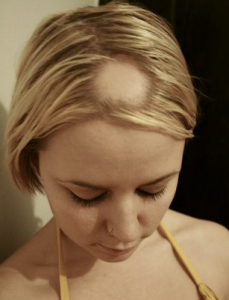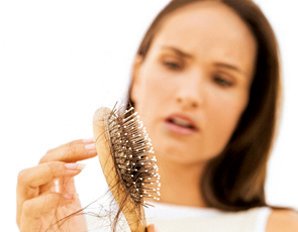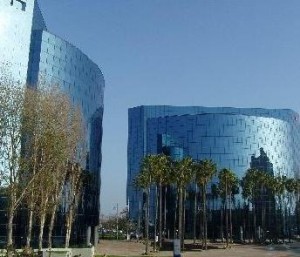Archive for the ‘Uncategorized’ Category
Friday, October 7th, 2011
 The autoimmune condition known as Alopecia causes hair loss in different areas of the body. These patchy, bald areas tend to look normal and don’t show any signs of inflammation or irritation. There is a genetic correlation found in some cases which can be linked to other autoimmune disorders. This particular form, Alopecia Areata, is most commonly a disease which is self-limiting, yet can be treated if necessary through steroid injections or topical medications by a dermatologist. The autoimmune condition known as Alopecia causes hair loss in different areas of the body. These patchy, bald areas tend to look normal and don’t show any signs of inflammation or irritation. There is a genetic correlation found in some cases which can be linked to other autoimmune disorders. This particular form, Alopecia Areata, is most commonly a disease which is self-limiting, yet can be treated if necessary through steroid injections or topical medications by a dermatologist.
The other form is known as Traction Alopecia which is common in children. This is a condition which is seen mainly in girls by having weak and fragile hair follicles. A common cause for this type of alopecia is tightly wrapped ponytails which in most cases affect the sides and front of the scalp. The initial sign of Traction Alopecia can be the elevation of the hairline. A way to treat this is by cutting the hair short and eliminating the strain the tightly wrapped hair causes on the follicles. The recovery time may take a few months and is spontaneous. In some of the longer term cases of Traction Alopecia, hair follicles are permanently damaged and a hair transplantation would be necessary to grow hair in the balding areas.
Tags: alopecia, alopecia areata, hair follicles, Traction Alopecia
Posted in Uncategorized | No Comments »
Friday, September 16th, 2011
There are times when patients suffering from the more advanced stages of balding require a second hair transplantation surgery to complete the process. The question many of these particular patients have is what the time lapse is between the first and second surgeries.
 This depends on if there is density which needs to be added to the already transplanted areas. If so, there needs to be at least six months which has passed since the original surgery. This is because after six months there is more complete growth from the first hair transplantation, and a touch up in the already transplanted areas will bring more complete results. The amount of hairs transplanted in the second surgery is typically less than the first since the scar from the first surgery is removed a second time. Overall, the greater the density in the transplanted areas, the better the hair restoration will look long term. This depends on if there is density which needs to be added to the already transplanted areas. If so, there needs to be at least six months which has passed since the original surgery. This is because after six months there is more complete growth from the first hair transplantation, and a touch up in the already transplanted areas will bring more complete results. The amount of hairs transplanted in the second surgery is typically less than the first since the scar from the first surgery is removed a second time. Overall, the greater the density in the transplanted areas, the better the hair restoration will look long term.
Tags: advanced stages of balding, hair transplantation surgery, second hair transplantation surgery
Posted in hair transplant, Hair Transplant Procedure, men hair restoration, Second hair transplant procedure, Uncategorized | No Comments »
Friday, March 4th, 2011
 Many patients that come in to my office have a common complaint; hair shedding (some even bring in a ball of hair they have collected from their brush and bathroom floor) and in most cases they are women with long hair. For the most part hair shedding alone is not a sign of hair loss. Shedding is losing thick hair that has completed its growth phase and started its resting phase. Many patients that come in to my office have a common complaint; hair shedding (some even bring in a ball of hair they have collected from their brush and bathroom floor) and in most cases they are women with long hair. For the most part hair shedding alone is not a sign of hair loss. Shedding is losing thick hair that has completed its growth phase and started its resting phase.
- Examples of Normal Hair Shedding
All humans experience a level of hair shedding. It can be up to 100 to 200 hairs per day. Hair shedding is sometimes more exaggerated in people who have had a large surgery, trauma, experienced physiological or emotionally stressful events and women who have recently delivered a child. This is called Telogen Effluvium (excessive temporary loss of telogen hair). In most cases hair shedding is typically temporary and the affected hair will grow back within a few months. There is no cause for concern, unless you have a more visible scalp or thinning of the scalp hair. In which case, you should come in to see a certified hair restoration surgeon.
- The 3 Stages of Human Hair Growth
- Anagen ( Growing stage)
- Catagen (Transitional stage)
- Telogen ( Resting stage)
- Active Hair Loss Determined by Miniaturization Study
Almost every patient that visits US Hair Restoration will have a miniaturization study performed on them, to evaluate their degree of the fineness of their scalp hair which are signs of active hair loss, or in other words scalp hair miniaturization. People with active hair loss show 20-30% more thinning hair than the average person who experiences normal hair shedding. If you feel that you are experiencing active hair loss, we recommend you come into one of our five offices in California( San Francisco, San Diego, Orange County, Beverly Hills and Encino), for a free consultation.
Tags: active hair loss, free consultation, hair growth, hair loss, miniaturization study, normal hair shedding, resting phase, scalp hair miniaturization, telogen efflevium, us hair restoration
Posted in Beverly Hills hair transplant, California hair transplant, Orange County hair transplant, San Diego hair restoration, San Francisco Hair Transplant, Uncategorized, women hair loss | No Comments »
Tuesday, November 30th, 2010
Q:
Good Afternoon Dr. Mohebi,
I recently was recommended to go on a medication for body building purposes by my trainer. The medication that I am planning on starting is called ANAVAR (an anabolic steroid). Because I am currently taking Propecia, as prescribed by you, I just wanted run ANAVAR by you to make sure it would be OK to take in conjuction with Propecia.
I appreciate all of your help, Thanks!
A:
Anavar (oxandrolone) is a weak androgen and is considered an anabolic steroid. It is indicated as adjunctive therapy to enhance weight gain after weight loss due to an extensive surgery, infectious disease, trauma and so on. Anavar has also been prescribed to some patients who for no reason fail to gain weight despite of  proper nutrition and work out schedules. It may also be used to maintain normal weight or to prevent the catabolism due to prolonged administration of corticosteroids. proper nutrition and work out schedules. It may also be used to maintain normal weight or to prevent the catabolism due to prolonged administration of corticosteroids.
There have been some online reports of hair loss with Anavar’s use and some exagerated hair loss reports in patients who take both Propecia (finasteride) and Anavar (oxandrolone) in conjunction. Although my personal searches in medical publications have never revealed any studies supporting this information, reports can be found online by its claimed users.
Overall, my general recommendation is: unless there is a strong medical indication for its use, people with any evidence of male patterned baldness should stay away from anabolic steroids. Although you may find some anabolic steroids over the counter, your family doctor should always be involved and aware of any anabolic steroids that you take as part of your body enhancing plan.
Tags: anabolic steriods and hair loss, Anavar, finasteride, hair loss, oxandrolone, propecia
Posted in hair loss complications, hair loss medication, hair loss products, hair transplant, men hair restoration, Uncategorized | No Comments »
Tuesday, November 30th, 2010
Following a hair transplant surgery, hiccups may develop due to several factors. Some of the main factors to cause this are: the medication that patient takes, possible local irritation of some nerve endings in the donor area (especially in strip technique hair transplant) and lastly, a patient’s diet.
These three possible causes are each explained in depth below.
Medication: Some medications that are given to the patient after a hair transplant surgery (i.e. – steroids) may increase the chance of developing temporary hiccups.
Diet: In the case that a patient develops hiccups due to his/her eating or drinking habits, his/her diet needs to be controlled. Alcoholic beverages, carbonated beverages or taking in large volumes of food may also increase the chance of developing hiccups.
Local nerve irritation: The local irritation of some nerve endings, such as the posterior auricular nerve or other branches of the cervical plexus may stimulate the phrenic nerve thus also causing hiccups.
If hiccups persist severely or beyond a few hours you are urged to contact your hair transplant surgeon for medical evaluation and treatment. Your doctor may prescribe you chlorpromazine (Thorazine) and advise you to continue taking these pills for a few days to avoid re-occurance of the hiccups.
Tags: after hair transplant, cervical plexus, chlorpromazine, hiccup, Hiccups, phrenic nerve, Thorazine
Posted in hair loss complications, hair transplant, Uncategorized | No Comments »
Thursday, November 18th, 2010
Hello blog readers,
I have some great news about US Hair Restoration’s current hair transplant costs!!
As the result of a recent meeting between my staff members and I, there will now be a Holiday Special beginning on December 1, 2010 at US Hair Restoration. This special will be offered for an extremely limited time and is one of the lowest prices for quality hair restoration yet.
We realize that holidays are quite busy for some people and that certain patients will need to book their procedure on a specific date in order to keep their schedules in tact. To accommodate this need of many of our patients, a rare discount of 40% off regular hair transplant costs will be offered to all of our valued clientele who have flexible schedules and are willing to book their procedures within 7-10 days of the procedure itself. By offering this discount to our patients with flexible schedules, we hope to accommodate the needs of all of our valued patients while not sacrificing the high quality that US hair Restoration stands by and is known for worldwide.
With this limited time discount, hair transplant costs at US Hair Restoration will be:
Offer only valid until January 31, 2011. Call 888-302-8747 to schedule your free consultation today. For additional information on the procedures we offer here at US Hair Restoration, feel free to check out our detailed webpages on Follicular Unit Transplants and Follicular Unit Extractions. We look forward to meeting you all in office soon!
Tags: cost of hair restoration, cost of hair transplant, hair restoration cost, hair transplant cost
Posted in Bakersfield hair transplant, California hair transplant, hair transplant, men hair restoration, Newport Beach hair transplant, Orange County hair transplant, San Diego hair restoration, san diego hair transplant, Uncategorized, women hair loss | No Comments »
Friday, October 22nd, 2010
Q:
Dr. Mohebi,
I live outside of California and am interested in seeing you for my hair restoration procedure. I have attached my pictures to this email along with a few quick questions that I have in regards to hair restoration. Could you please check them out whenever you have a free moment and let me know what your personal recommendations are?
- What is the approximate number of grafts required to achieve sufficient density (if not a lot) and the approximate cost of the whole process?
- How long will it take me to get back to my work and how soon I will see the results?
- Lastly, please do let me know any other important information that is relevent to the his whole procedure.
Thanks!
A:
Dear Inquirer,
First off, I just want to thank you for your interest in our hair restoration services and let you know that I have forwarded your information and pictures to be included in our patient information system for further review. I also wanted to take a quick moment to look over your photos and respond personally to your inquiries.
Here are my responses to your questions in the order they were received:
- What is the approximate number of grafts required to achieve sufficient density (if not a lot) and the approximate cost of the whole process?
You are a class VI hair loss patient and would require the maximum number of grafts possible in one session to acheive the density you are striving for. The number is generally above 2500 grafts for people who have never had a surgery, but may fluctuate through the range of 2500 to 4000 grafts based on your own scalp laxity and density of hair (to be determined when you are here in our office).
The cost for hair transplants at US Hair Restoration are based on the number of grafts transplanted and the standard charges are as follows for Follicular Unit Transplants:
- $4 per graft for the first 2500 grafts; all additional grafts are charged at half price ($2 per graft).
In addition, your travel expenses will be reimbursed towards 10% of the cost of surgery (up to $500).
In addition to reimbursement on travel, we will book a hotel near our office for you for 2 nights with free transportation between the hotel and our office for your visits.
Lastly, we also have a standby program available for anyone which a flexible schedule and willingness to book their surgery date within 7-10 days of the procedure itself (visit us at www.ushairrestoration.com for more information on that offer).
- How long will it take me to get back to my work and how soon I will see the results?
The procedure for a strip hair transplant takes one whole day (from approximately 7am to 5pm) and you are required to return the day after for your procedure for a hair wash. With these basic requirements, you have the capability to fly back home as early as the day after your surgery and continue all routines as before (aside from hair washing which you will do as instructed for the first 4 days following the procedure). You will be fully functional the first day after surgery, but you may have some swelling for 3-4 days following.
Visible results of your hair transplantation will be seen approximately 6-10 months following the procedure itself and may continue to develope into the year and a half mark.
- Do let me know any other important information that is relevent to the his whole procedure.
You can find more great information about hair transplant methods with US Hair Restoration on our website: www.ushairrestoration.com or our blog: www.ushairrestoration.com/blog
Tags: before hair transplant, Consultation, General Hair Transplant Information, Graft Number Inquiry, hair transplant, Patient Inquiry
Posted in California hair transplant, hair transplant, men hair restoration, Uncategorized | No Comments »
Tuesday, June 29th, 2010
 Finally, US Hair Restoration San Diego Office begin its work today. As promised before the first patients who book their hair transplant surgery from the San Diego office of US Hair Restoration will receive special discounted rates toward their hair transplantation. US Hair Restoration South California presence was further established by opening Southern office in La Jolla Area of San Diego, California. Finally, US Hair Restoration San Diego Office begin its work today. As promised before the first patients who book their hair transplant surgery from the San Diego office of US Hair Restoration will receive special discounted rates toward their hair transplantation. US Hair Restoration South California presence was further established by opening Southern office in La Jolla Area of San Diego, California.
US Hair Restoration uses advanced communication tools to educate the hair loss patient in Southern California. US Hair Restoration San Diego office evaluates patients through its knowledgeable staff. All primary planning for a hair transplant surgery is initiated in the San Diego Hair Loss Treatment Center. Dr. Mohebi oversees all patients initial consultations in San Diego office while he supervises the follow up visits of the previously treated patients by US Hair Restoration.
Starting another branch of US Hair Restoration is one step further toward our goal of providing quality hair restoration services with an affordable prices to everyone.
Tags: California hair loss treatment, La Jolla hair restoration, San Diego hair resoration, san diego hair transplant, Southern California hair loss treatment
Posted in San Diego hair restoration, san diego hair transplant, Uncategorized | No Comments »
Saturday, April 10th, 2010
Q:
Several weeks have passed since my hair transplant surgery. It has come to my attention that there’s a small bald spot near my left ear. As told, I was keeping that area clean the last few weeks, but no hair has grown back, it is still the same. I do not think it is getting larger. For some reason, the bald area is more sensitive to heat or cold temperatures. I was washing my hair today, and a scab fell off, but it was about the same size as the bald spot.
Another thing, I feel numb in the surrounding area of the bald spot. For me, I’ve never seen a bald spot in my donor wound until now. I’m wondering what I can do about it. I guess trauma leads to falling out of hair in donor wound areas as well. Just to let you know, I’ve been taking doses of finasteride daily, before, during the time I had surgery, and after surgery. Comparing to times past, I think I’ve taken pretty nice care of my head vs. the other times I had hair transplant surgeries, so I’m a bit concerned.
I wonder if the hair will ever grow back, as long as there isn’t a scar over it. My bald spot is about the size of a silver dollar; it looks quite noticeable. The bald spot has been overly sensitive the whole time after the surgery, but it wasn’t infected and there was no blood oozing out of it. I’m thinking that maybe the hair surrounding the wound fell off because of shock.
Your advice would be much appreciated,
A:
I appreciate the email. You guessed right about the hair loss probably being caused by shock around the area of your donor wound. There must have been really tight close-up of the donor area. Maybe the hard close-up caused the shock loss. The two areas, on either side of the scalp, are very vulnerable to shock loss. Usually, when shock loss occurs, it happens on both sides. Shock loss occurring around a donor wound is, most of the time, reversible. It takes about six months for hair lost because of shock loss to grow back. It’s a slow, but certain process. Stay patient.
At this time, there is not a lot that can be done. But it is important that a doctor takes a look at your shock loss. Also, the feeling of numbness in the donor area will last up from a few weeks to months. The numbness is caused by inflaming of the healing area, this has an effect on the nerves in that area. It will heal on its own time.
Tags: donor hair transplant, donor wound after hair transplant, hair restoration and donor scar, shock loss
Posted in hair loss complications, hair transplant, Uncategorized | No Comments »
Friday, March 26th, 2010
One day I was flipping through a publication and came across a case study in which there was found to be hair growing in a person’s mouth. The study was reported by the U.S. National Library of Medicine.
Earlier this year, a female subject was discovered to have, within her mouth, hair growth. It was the type of hair found in human nostrils. Researchers made the point that it was because of the excessive amounts of testosterone in her body. The condition is called oral hirsutism. Lots of diseases and health conditions can affect the body when there is too much testosterone circulating around. According to studies, the principal cause of hirsutism is polycystic ovary syndrome (PCOS).
Some day in the next few decades, lab scientists studying hair follicle growth might be able to take advantage of testosterone to grow hair on men and women scalps, especially for those who are prime candidates for hair loss treatment.
This particular case study has been credited to F. Femiano, R. Rullo, R. Serpico, A. Lanza, V.M. Festa, and G. Laino. At the Second University of Naples, in Naples, Italy.
Tags: hair in mouth, hirsutism, pcos
Posted in Uncategorized | No Comments »
|
|
 The autoimmune condition known as Alopecia causes hair loss in different areas of the body. These patchy, bald areas tend to look normal and don’t show any signs of inflammation or irritation. There is a genetic correlation found in some cases which can be linked to other autoimmune disorders. This particular form, Alopecia Areata, is most commonly a disease which is self-limiting, yet can be treated if necessary through steroid injections or topical medications by a dermatologist.
The autoimmune condition known as Alopecia causes hair loss in different areas of the body. These patchy, bald areas tend to look normal and don’t show any signs of inflammation or irritation. There is a genetic correlation found in some cases which can be linked to other autoimmune disorders. This particular form, Alopecia Areata, is most commonly a disease which is self-limiting, yet can be treated if necessary through steroid injections or topical medications by a dermatologist.
 This depends on if there is density which needs to be added to the already transplanted areas. If so, there needs to be at least six months which has passed since the original surgery. This is because after six months there is more complete growth from the first hair transplantation, and a touch up in the already transplanted areas will bring more complete results. The amount of hairs transplanted in the second surgery is typically less than the first since the scar from the first surgery is removed a second time. Overall, the greater the density in the transplanted areas, the better the hair restoration will look long term.
This depends on if there is density which needs to be added to the already transplanted areas. If so, there needs to be at least six months which has passed since the original surgery. This is because after six months there is more complete growth from the first hair transplantation, and a touch up in the already transplanted areas will bring more complete results. The amount of hairs transplanted in the second surgery is typically less than the first since the scar from the first surgery is removed a second time. Overall, the greater the density in the transplanted areas, the better the hair restoration will look long term.
 proper nutrition and work out schedules. It may also be used to maintain normal weight or to prevent the catabolism due to prolonged administration of corticosteroids.
proper nutrition and work out schedules. It may also be used to maintain normal weight or to prevent the catabolism due to prolonged administration of corticosteroids.

